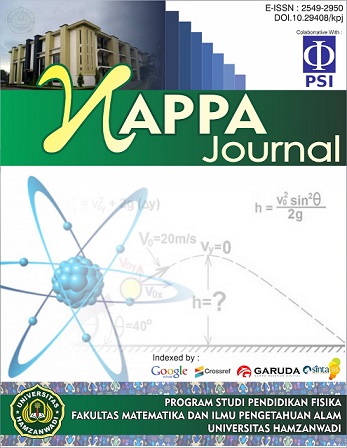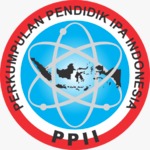Analysis of Solar Flux and Sunspot Correlation Case Study: A Statistical Perspective
DOI:
https://doi.org/10.29408/kpj.v7i1.12238Keywords:
Solarflux, Sunspots, Radiation intensity, Analysis correlation, Impact solarflux and, sunspotsAbstract
This analysis examines the relationship between the number of solar flares and the number of sunspots in 2005 using 11 observations in months 2 to 12. The number of solar currents measures the intensity of the radiation emitted by the Sun, while the number of sunspots measures the number of sunspots on the surface of the Sun. Multivariate linear regression analysis was used to analyze the relationship between Solar Current Rate and Number of Sunspots. The results of the analysis show that the coefficient of the Amount of Solar Current is 1.1239 with a significant t value of 2.510 (probability that there is no effect on the Number of Sunspots is 3.33%). The linear regression model has good results with an F-statistic value of 6.301 and a p-value of 0.0333, with an R-squared value of 0.4118 which indicates that 41.18% of the variation in the number of sunspots is influenced by variations in the amount of solar currents. The corrected R-squared value is 0.3464 indicating that there are still variations in the number of sunspots that cannot be explained by variations in the number of solar currents. ARIMA analysis results show an MA coefficient of 0.7351 with an average value of 45.9542 and a s.e value of 0.2590 and 6.1550 respectively. The AIC, AICc, and BIC values are 92.97, 96.4, and 94.16. The error results in the training set show that the ME value is 0.2615561, the RMSE value is 12.16969, the MAE value is 9.03306, the MPE value is -15.14689, the MAPE value is 30.42013, and the MASE value is 0.674109. The ACF1 value in the exercise set is 0.0808969.
References
Ansor, N.M., Hamidi, Z., Shariff, N., 2019. The impact on climate change due to the effect of global electromagnetic waves of solar flare and coronal mass ejections (CMEs) phenomena. Presented at the Journal of Physics: Conference Series, IOP Publishing, p. 012019.
Aparicio, A., Gallego, M., Antón, M., Vaquero, J., 2020. Relationship between solar activity and direct solar irradiance in Madrid (1910–1929). Atmospheric Res. 235, 104766.
Armstrong, R.A., 2019. Should Pearson’s correlation coefficient be avoided? Ophthalmic Physiol. Opt. 39, 316–327.
Avraam, D., Wilson, R., Butters, O., Burton, T., Nicolaides, C., Jones, E., Boyd, A., Burton, P., 2021. Privacy preserving data visualizations. EPJ Data Sci. 10, 2.
Cao, B., Feng, J., An, L., 2022. Long-term relationship between foF2 from China ionospheric stations and solar activity during the 24th solar activity cycle. Radio Sci. 57, 1–11.
Davies, S.J., Abiem, I., Salim, K.A., Aguilar, S., Allen, D., Alonso, A., Anderson-Teixeira, K., Andrade, A., Arellano, G., Ashton, P.S., 2021. ForestGEO: Understanding forest diversity and dynamics through a global observatory network. Biol. Conserv. 253, 108907.
Geryl, P., Alvestad, J., 2020. A formula for the start of a new sunspot cycle: Relating the adjusted 10.7 cm solar flux to the start of a new sunspot cycle. Astrophys. Space Sci. 365, 113.
Hinne, M., Gronau, Q.F., van den Bergh, D., Wagenmakers, E.-J., 2020. A conceptual introduction to Bayesian model averaging. Adv. Methods Pract. Psychol. Sci. 3, 200–215.
Kaliyadan, F., Kulkarni, V., 2019. Types of variables, descriptive statistics, and sample size. Indian Dermatol. Online J. 10, 82.
Kane, S.R., Arney, G.N., Byrne, P.K., Dalba, P.A., Desch, S.J., Horner, J., Izenberg, N.R., Mandt, K.E., Meadows, V.S., Quick, L.C., 2021. The fundamental connections between the Solar System and exoplanetary science.
Kjelseth, I.M.E., 2020. Intensity Contrast as a Function of Underlying Magnetic Field Through the Solar Atmosphere.
Leka, K., Park, S.-H., Kusano, K., Andries, J., Barnes, G., Bingham, S., Bloomfield, D.S., McCloskey, A.E., Delouille, V., Falconer, D., 2019. A comparison of flare forecasting methods. II. Benchmarks, metrics, and performance results for operational solar flare forecasting systems. Astrophys. J. Suppl. Ser. 243, 36.
Maliniemi, V., Asikainen, T., Salminen, A., Mursula, K., 2019. Assessing North Atlantic winter climate response to geomagnetic activity and solar irradiance variability. Q. J. R. Meteorol. Soc. 145, 3780–3789.
McGranaghan, R.M., Ziegler, J., Bloch, T., Hatch, S., Camporeale, E., Lynch, K., Owens, M., Gjerloev, J., Zhang, B., Skone, S., 2021. Toward a next generation particle precipitation model: Mesoscale prediction through machine learning (a case study and framework for progress). Space Weather 19, e2020SW002684.
Mishra, H., Garofalo, G., Giordano, A.M., Ott, C., 2020. On the dynamics of floating-base robots: Linking the recursive formulation to the Reduced Euler-Lagrange Equations. Preprint 10.
Mukhtar, M., Jushua, B., Bonde, D., Kaoje, M., Asabe, B., Sulaiman, M., 2021. The relationship between sunspots number and some lower atmospheric parameters at solar minimum of solar cycle 24. Int. Res. J. Mod. Eng. Technol. Sci. 3, 228–233.
Nandy, D., 2021. Progress in solar cycle predictions: Sunspot cycles 24–25 in perspective: Invited review. Sol. Phys. 296, 54.
Penza, V., Berrilli, F., Bertello, L., Cantoresi, M., Criscuoli, S., Giobbi, P., 2022. Total Solar Irradiance during the Last Five Centuries. Astrophys. J. 937, 84.
Rohmer, J., 2020. Uncertainties in conditional probability tables of discrete Bayesian Belief Networks: A comprehensive review. Eng. Appl. Artif. Intell. 88, 103384.
Shiokawa, K., Georgieva, K., 2021. A review of the SCOSTEP’s 5-year scientific program VarSITI—Variability of the Sun and Its Terrestrial Impact. Prog. Earth Planet. Sci. 8, 1–43.
Shrestha, N., 2020. Detecting multicollinearity in regression analysis. Am. J. Appl. Math. Stat. 8, 39–42.
Tian, L., Oviatt, S., Muszynski, M., Chamberlain, B., Healey, J., Sano, A., 2022. Applied Affective Computing.
Washington, S., Karlaftis, M., Mannering, F., Anastasopoulos, P., 2020. Statistical and econometric methods for transportation data analysis. Chapman and Hall/CRC.
Widén, J., Munkhammar, J., 2019. Solar radiation theory. Uppsala University.









